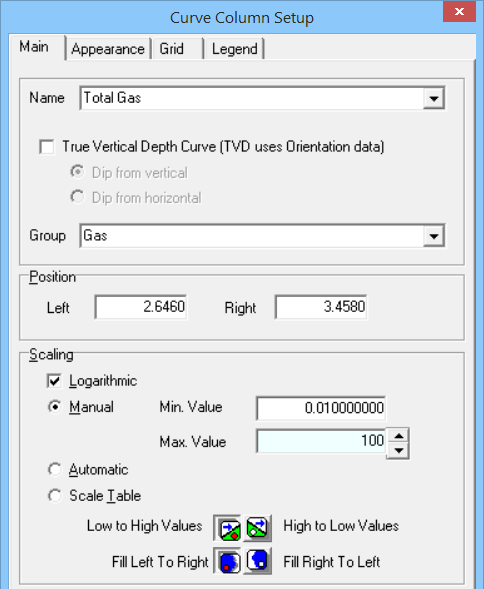
Use the settings on the Main tab of the Curve Column Setup window to define the name and positioning for the curve column, and to establish the data range and scaling.

The name you declare must match, character-for-character, the name for the curve data listed in the data file. The name match is not case-sensitive.
! True Depth Curves:
If you want to display true depth in the curve, rather than downhole data, you should set the Name field to the name of the Orientation datasheet containing the downhole survey data.
Then, insert a check in the True Depth Curve check box. Specify whether the downhole survey data is entered as dip from vertical (0 = straight down and 90 = horizontal) or as dip from horizontal (0 = horizontal, -90 = straight down, +90 = straight up, as entered in RockWorks).
See the other true-depth-specific notes regarding the scaling, below.

Logarithmic: Insert a check here if the curve is to be scaled logarithmically (log base 10) within the column. If left un-checked, the curve will be scaled linearly across the column.
Minimum and Maximum Values: These settings define the range of data values to be represented in the curve column.
Manual: This is the default setting. This allows you to define manually the data values to correspond to the left and right column edges via the Min. Value and Max. Value boxes.
- Linear Scaling: Simply type in the data value range to be represented in the curve column. For example, if the column is to contain drilling rate values that are to be plotted from 0 to 60 feet per minute, you would enter "0" for the Min. Value and "60" for the Max. Value.
- Logarithmic Scaling: For the Min. Value, enter the non-negative and non-zero real number to represent the minimum value of the logarithmic curve column. You may then select the appropriate Max. Value using the up- or down-arrows next to that prompt. You are restricted to even logarithmic cycles, such as 0.2 to 2,000, 1 to 10,000, etc.
- If Logarithmic Scaling is selected and the program encounters a zero or negative value in the data file, that value will be plotted at the minimum-value edge of the column.
- ! True-Depth Curves: These special-case curves don't display measured data, but instead are used to represent drilled depths versus actual elevations as a curve. You should set the Min. Value to the lowest true elevation and the Max. Value to the elevation at the top of the well.
Automatic: Choose this option if you want the curve's minimum and maximum values to be determined automatically by the program, based on the data values, at compile time. LogPlot will scan the data values and set the curve scale to a reasonable min-max range to accommodate the values. For example, if the data ranges from 1.6 to 8.2, it would set the curve column's linear Min. Value to 0 and the Max. Value to 10.
- If you have header/footer column legends linked to the curve, they should be updated appropriately.
- If you have activated automatic value labels within the column itself, they should be updated appropriately.
- It's important to note that Automatic scaling will probably result in the curve column's min-max value range varying from well to well, based on the data range represented - if it is important that the curve column represents the same data range for all wells in a project, you should use the Manual option.
Scale Table: Choose this option if you want to change the horizontal scale for a curve for one or more depth intervals in the log. This can be handy for display of abrupt drilling rate changes, for example.
- This requires a Scale Table be present in the data file, which defines the top and base depth and the minimum and maximum column values for that depth range. The Scale Table must have the same name as the curve column. If no Table is found, the program will use the Manual settings for the column.
- Header/footer column legends will not change for these scale changes.
- Automatic value legends will be updated for these scale changes.
Direction:
Low to High: Click this button if the data values are to be plotted from left to right, with the minimum value along the left column edge and the maximum value along the right column edge.
High to Low: Click this button if the data are to be plotted from right to left, with the minimum value along the right column edge and the maximum value along the left column edge.
If you have set the curve appearance to be filled (as specified under appearance settings) and you want the solid fill to be to the left of the curve, click on the Left to Right button. If the solid fill is to be to the right of the curve, click on the Right to Left button. This operates independently of the actual min-max direction of the curve.
![]() Back to main topic
Back to main topic